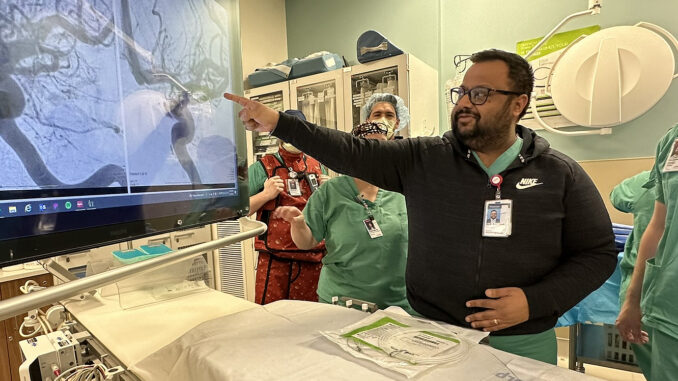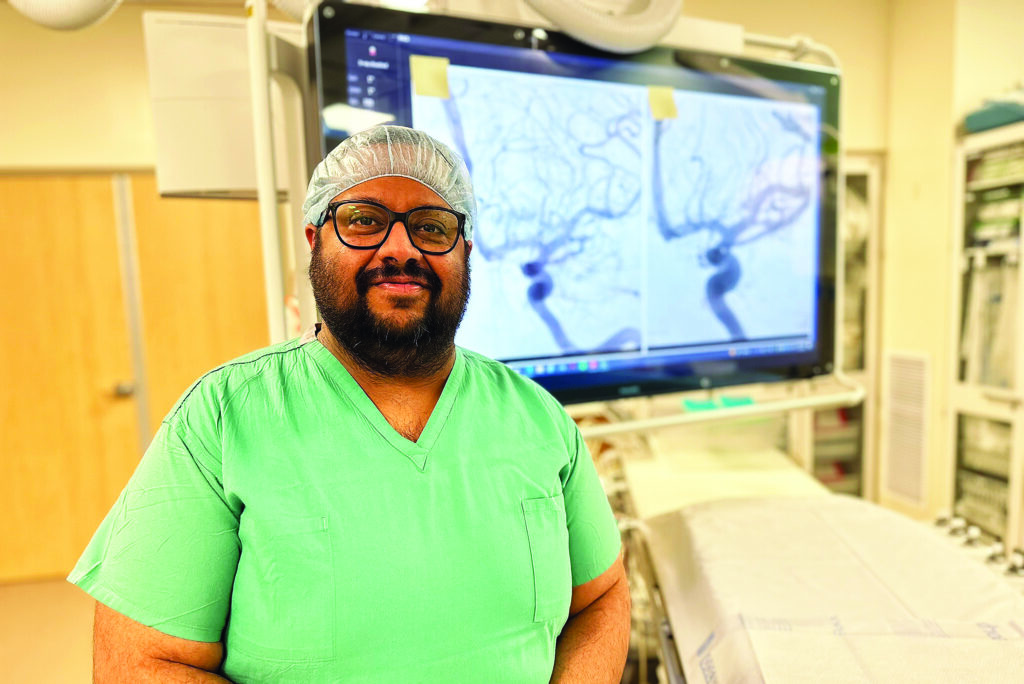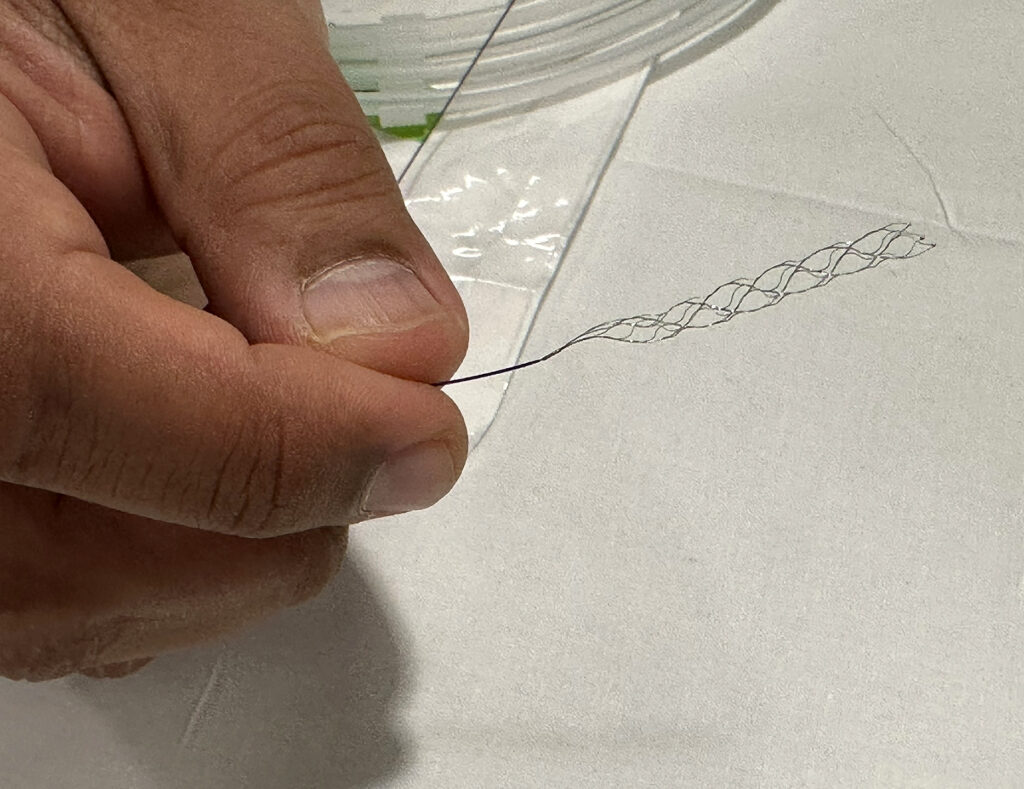
Medical Center of the Rockies launches mechanical thrombectomy program.
Experts at UCHealth Medical Center of the Rockies (MCR) are now treating some stroke patients with a minimally invasive procedure that not only saves lives but also can lead to a higher quality of life after stroke.
This advanced technique – called a mechanical thrombectomy – removes some of the most damaging and life-threatening blood clots that get lodged in the brain’s large central vessels and aims to restore blood flow to the brain.

“Time is critical in this type of procedure,” said Dr. Gautam Sachdeva, a vascular and interventional neurologist at MCR who moved to northern Colorado last year to help build the thrombectomy program. “We have seen this time and time again – if this is done in a timely manner and there has not been significant brain damage already, there is a very high chance of near complete reversal of deficits.”
How does it work? A thin flexible tube – or catheter – is inserted into an artery in the groin or arm. With the help of X-ray guidance, an interventional neurologist guides the catheter to the blood clot in the brain. Then, a special device inserted through the catheter is used to engage the clot and pull it out to restore blood flow to the brain. The interventional neurologist can also use a technique that sucks the clot out if need be. The procedure typically takes less than an hour.
A mechanical thrombectomy is most effective the sooner it is performed after a stroke, according to Sachdeva. Traditional clot-busting medications are only an option for patients in the first 4.5 hours after the first symptoms appear, and they don’t always work on large clots. The thrombectomy can be offered up to 24 hours from the last time the patient was functioning normally.

Patients often recover quickly after the procedure itself. Overall recovery depends on how significant the stroke was prior to the procedure. In an optimal situation with no significant brain damage and a timely and successful intervention, some patients start moving their paralyzed side and talking immediately after the procedure, walking the next day, and even getting discharged home in a couple days. If there is more damage, it could take a few days and even a rehabilitation stay after the procedure. UCHealth follows up with these patients in 2-4 weeks in the outpatient setting after the procedure to make sure they are doing well and are on optimal medications to prevent future strokes.
MCR is the first hospital between Denver, Colorado, and Casper, Wyoming, to offer this advanced procedure. In the past, patients who needed this care had to be rushed to Denver if there was time. Now that it’s available at MCR, patients can get the care quicker and closer to home.
“Launching this program in northern Colorado is a significant development for our community because if a patient is experiencing a major stroke here, we can take care of it right away, and the patient will have a much higher chance of excellent recovery,” Sachdeva said.
The addition of the thrombectomy program further strengthens MCR’s position as a regional leader in stroke treatment. The hospital is already designated by The Joint Commission as a Primary Stroke Center, a classification awarded to programs that have the staff, resources and processes in place to deliver fast, advanced care to stroke patients. It is consistently a top-performing center with years of recognition from the American Heart Association and American Stroke Association. The program’s experts also provide extensive outreach and stroke education to the community as well as emergency medicine responders, partnering facilities and agencies throughout northern Colorado, Wyoming and western Nebraska.
BE FAST
A stroke can happen at any age and any time. That’s why UCHealth vascular and interventional neurologist Dr. Gautam Sachdeva urges everyone to know and watch for the signs of stroke. “BE FAST” is an easy way to remember sudden signs of stroke:
- Balance. Sudden loss of balance or inability to walk straight.
- Eyes. Sudden loss or changes in vision.
- Face. Uneven smile or drooping of mouth.
- Arm. Sudden loss of arm strength or coordination.
- Speech. Inability to speak clearly or to understand what is being said.
- Time. Time to call 911 if you suspect stroke symptoms.
About UCHealth
UCHealth is an innovative, nonprofit health system that delivers the highest quality medical care with an excellent patient experience. UCHealth includes 33,000 employees, 14 acute-care hospitals and hundreds of physicians across Colorado, southern Wyoming and western Nebraska. With University of Colorado Hospital on the CU Anschutz Medical Campus as its academic anchor and the only adult academic medical center in the region, UCHealth is dedicated to providing unmatched patient care in the Rocky Mountain West. Offering more than 200 clinic locations, UCHealth provides extensive community benefits and pushes the boundaries of medicine through advanced treatments and clinical trials, improving health through innovation.
Support Northern Colorado Journalism
Show your support for North Forty News by helping us produce more content. It's a kind and simple gesture that will help us continue to bring more content to you.
BONUS - Donors get a link in their receipt to sign up for our once-per-week instant text messaging alert. Get your e-copy of North Forty News the moment it is released!
Click to Donate
